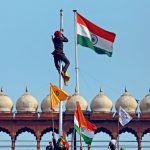Reductive India
Another foreign correspondent falls for clichés in his haste to explain a country he has scarcely understood
 Prayaag Akbar
Prayaag Akbar
 Prayaag Akbar
Prayaag Akbar
 |
14 Apr, 2014
|
14 Apr, 2014
/wp-content/uploads/2015/11/books-prayag.jpg)
Another foreign correspondent falls for clichés in his haste to explain a country he has scarcely understood
‘First they ignore you, then they laugh at you, then they fight you, then you win.’
There is a subset of humanity that is wont to put up inspirational quotes on Facebook, impelled, it seems, by their wish to instantly transform the lives of each of the 999 faux-friends they have accumulated. The quote above is a favourite of this group. It speaks of non-violent resistance, of perseverance despite animus, and so, with the internet’s ready logic, it has been attributed to MK Gandhi, or, more frequently, MK Ghandi. That the real Gandhi tended to be loquacious rather than pithy makes the quote rather suspect, and a brief investigation reveals that it is in fact a mangled extract from a 1914 address given in Baltimore by a man named Nicholas Klein, at the Third Biennial Convention of the Amalgamated Clothing Workers of America. Slightly less internet-resonant, that.
Yet, the internet’s favoured phrasing does have a certain appeal, and it was this quote that I thought of as I read John Elliot’s new book, dramatically titled Implosion (why eschew the exclamation point this title surely demands?). Elliot, a former Financial Times correspondent, is the latest in a line of foreign writers that have produced big books seeking to make a large and definitive pronouncement on India. This is not to tar all with the same brush: there are some nuanced and relevant accounts that have benefited from being written with an outsider’s perspective. This book is not one of them. India, it seems, has gone past the ‘ignore’ stage, survived the ‘laugh’ stage (what a quaint democracy, filled with film star politicians and illiterates voting and manipulated elections), and is now at Stage Fight. I wonder when we will win. Perhaps, when Mr Modi is vetting all the copy himself.
Too many of these books conform to the headline-cycle, which is inextricably linked to the economic cycle, and the first thing John Maynard Keynes taught us was that capitalist economies will have both boom and bust. The problem is that a book takes more time to write than a headline, and inevitably, books of this kind always seem a year or two late. Certainly Implosion seems a particularly strange title now, when India’s economic indicators are up, and foreign investment is up, and the nation is about to embark on the largest electoral exercise in the world.
How else to explain the confidence with which such strange assertions are made on Page 1: ‘At the heart of this national approach is what is known as jugaad, which means making do and innovating with what is available, and chalta hai, which means ‘anything goes’ and hoping for the best.’ Really? At the heart? I wonder what the 299 members of the Constituent Assembly, which convened for nearly three years under the guidance of one of the finest minds of the twentieth century, BR Ambedkar, would make of that. Forget the past. What would the multiple nodes of governance that now oversee so much in this highly-complex democracy— everyone from the panchayats to RBI—make of that? It is this kind of infantilising that so aggravates Indian commentators, and leads to debates titled ‘Who Can Write About India?’ The answer to that question is quite simple: anyone can write about India, provided the writer has a point worth making, and bases it on evidence. To ground a lengthy analysis on the idea that jugaad and chalta hai typify our nation’s approach to most matters of importance is unforgivably reductive, and simply inaccurate.
Elliot’s reading of India relies on a suspicion of its difference. It is not an angry suspicion; he seems fond of the culture but unable to process its workings. His unconscious comparison—especially on matters of business and economy, with which this book is chiefly concerned—is always with the West. So, corporate and cultural practice there provides a kind of baseline of what is both normal and desirable. The deviations he detects in India, of which there are many, are thus malignancies instead of fruitful areas of investigation. This is why he argues that all entrepreneurial production in Dharavi, which he himself reports comprises somewhere between $750 million-$ 1 billion a year, is jugaad, and not small-scale production and self-ownership; because it looks very little like industrial activity in the West. Later, he cites a chair manufacturer who sources parts from places like China and Malaysia, and sells a quality chair at half the price. The shop might look unusual to your eyes, the shopkeeper might tell you of his stomach troubles while selling you the chair, but that does not make it jugaad (though Elliot does seem to meet a lot of people—plumbers, executives, academics, jungle camp workers—who pepper their conversations with the term). The chair maker seems to me simply a businessman, one acquainted with intelligent sourcing and cost-competition. Later, Elliot becomes even looser with the concept, using it to describe Dhirubhai and Reliance’s rise, when crony capitalism would be more accurate, or Sonia Gandhi’s back-office political manoeuvring. Crony capitalism is to be found everywhere, and power puppetry is certainly not limited to India, but that would detract from the book’s thesis: that India’s cultural and ethical particularities are leading it down a disastrous path.
Or when he writes, for instance, that Indians at every level of enterprise ‘pray for success at work’. He cites the shopkeeper at his local market, who prays each day before entering his shop, a bureaucrat praying at his desk, the extravagant donations of tycoons like Vijay Mallya to Tirupati. This reliance on the gods, he says, is where India’s chalta hai attitude comes from. What he ignores is that exhortations to God for economic success have been around since man first looked at the sky and asked for a roof and snack. People pray in the West, everyday, for economic success, and at every level of enterprise. What he sees as an essential difference is, instead, an expression of culture: unlike the West, in India religion enters the public sphere repeatedly and dramatically. Religiosity is a point of pride, and frequently a point of competition. Mallya’s travails might make him a convenient example, but by all accounts Mukesh Ambani, Sameer Jain and any number of others on India’s rich list are rather more ascetic than our King of Good Times, and none of them strike one as the bhagwaan-bharose type.
Elliot is right, of course, to point to the malaise that has afflicted the Indian growth story. Political and corporate corruption, cronyism, inequality and illegal plunder besiege us. But surely, if this last West-created global recession has taught us anything, it is that corruption and cronyism exist even in the air-conditioned hallways of Manhattan and the City of London, that it is endemic to capitalism and will spawn in any setting where an unwarranted control over information and access combines with the possibility of profit. What he fails to demonstrate is why India’s experience with deep corruption will prove ultimately fatal—unlike, say, Italy’s—and cannot be addressed by strengthened institutions and our increasing demands for accountability. What he fails to demonstrate is that there will, in fact, be an implosion (every time I type out the title I find myself looking at the sky, like Chicken Little, and wondering when it will fall on my head). Even Elliot’s own conception of a ‘creeping inward collapse’ seems most hyperbolic.
The problem with this book is it fails to come to the heart of the great problems India does face. It is a top-down look at various ailments that too often relies on the kind of prejudices that you hear around Delhi dinner tables. So the Kumbh Mela of 2013 is a shining example of organisational success, because one official was invested with overall administrative powers, and he did not have to kowtow to unseemly politicians. Ignore, I suppose (though the magazine Down to Earth did not), the tremendous long-term environmental damage done (ironically, this year’s edition was called the ‘Green Kumbh’), or that, as reported in The Hindu, the administration used members of a Scheduled Caste, Safai Karamcharis, to effect a filthy cleaning job, and then promptly washed its hands of the mess as soon as the Mela was over, leaving another caste (Nishads) to manually scavenge through lakes of putrid waste.
There’s more. Urbanisation woes? Ignore the skewed delivery of services to the rich and poor, and assign blame to the most disempowered. You see, ‘Politicians owe primary allegiance to slum dwellers… who are content with their semi-legal lifestyle where they pay little or nothing for services.’ Or, later, when he argues that the reason Dharavi has not been surrendered to ‘real estate firms’ redevelopment schemes’ (oh, joy!) is that they have ‘a vested interest in life as it is’ — there’s that great Indian indolence again, making its people want to remain forever in illegal slums, as free riders in the Indian state, when in fact it is the land compensation offers that are pitiful, and that no one offers a method of replicating the economies of scale and benefits of geographically- concentrated industry that Dharavi provides, or factors in the cost of moving from the centre of the city to the periphery. It is these crucial misunderstandings of the experience of the poor in India—not Elliot’s own, but imbibed through many years of speaking to India’s economic and social elite—that have propelled Arvind Kejriwal into the position he is today. For all his faults, Kejriwal listens to the poor, instead of charting the trajectory of their plight from above.
This is not to suggest that Elliot absolves those in power. He alludes frequently to political nexuses, though prefers for the most part not to name officials and politicians. His focus on upper-level politics and economics can be instructive, as in the discussion on 1991’s Liberalisation reforms, when he writes that Montek Singh Ahluwalia has confirmed to him in conversation that he was the principal intellectual force behind the framework which would be adopted, or of the evening in 2009 when Manmohan Singh faced a cogent and cutting critique from some of the most respected economists in India. Yet it is this kind of nugget, surely plentiful to a reporter of Elliot's experience, that in fact demolishes his own thesis. They show India to be a functioning, if troubled, democracy. That we have public protest at various governmental failures is not a sign that our democracy is failing: it is quite the opposite, showing that there is an increasing politicisation of the populace; that people will not, as was the case for decades after Independence, passively accept governmental decree; that civil society—crucial to democratic development in young nations, as Khilnani and Kaviraj established— thrives. Compare this with the violent political action that has subsumed so many nations trying to concretise democracy in the last half of the twentieth century and you will see what I mean. Elliot has a knack of identifying problems, but his conclusions do not satisfy.
In 1967, Samuel Huntington published Political Order in Changing Societies, a book that confirmed his position as the star political analyst of America. In it, he looked at how societies needed to progressively work towards modernisation, with political order as a primary objective—existing democratisation theory had enshrined the European or North American model of social development, twinning the goals of economic development and political stability, and believed it replicable throughout the world. Huntington, from the Right, and the American intellectual Left, effectively exploded the notion that economic development brought political stability (and perhaps we would all have been spared some earache if they’d informed Bob Geldof and Bono of their findings). One of Huntington’s key arguments was that for political order, social mobilisation must not outpace political institutionalisation—the strength of a nation state’s institutions are key; it is not the fact of elections, which are easily perverted, but the scope and effectiveness of the Election Commission (amongst a network of other such institutions) that decides the fate of a democracy. Quite simply, whether it will ‘implode’ or not.
Huntington writes, in 67: ‘India, for instance, was typically held to be the epitome of the underdeveloped society. Judged by the usual criteria of modernisation, it was at the bottom of the ladder… yet in terms of political institutionalisation, India was far from backward. A well-developed political system has strong institutions to perform both the “input” and “output” functions of democracy.’ He then cites the strength of the Indian Civil Service and the Congress party (of the first two decades of Independence, before its top-led institutional debilitation), and the slow pace of modernisation and social mobilisation as key factors in India’s political stability.
Elliot writes from the vantage of two-and-a-half decades after Liberalisation, when modernisation and social mobilisation have been in great acceleration, and yes, the Congress is no longer the stabilising force it once was. But it is hard to argue, as Elliot seems to be arguing, that our political institutions have become so debile that they will no longer work. If anything, the political churn shows that truly participative democracy is spreading, that people can find approximations of their political aspirations from the choices on offer.
Ultimately, this book seems a kind of Shantaram of the non-fiction world, except it is India’s economic culture that is eternally charming and problematic and contradictory. Its people might be lovely and talented, but they are also riddled with fatal idiosyncrasy and superstition and a culture of indolence. Some will find such an account sufficient. Others will not. Perhaps one day Johnny Depp will make a movie.
About The Author
CURRENT ISSUE
Rashmika Mandanna: India’s Sweetheart
MOst Popular
4

/wp-content/uploads/2025/04/Cover-Rashmika-New.jpg)











More Columns
Saving Farmers from the Unions Siddharth Singh
The New Hotspot Kaveree Bamzai
Chills and Spills in Small Town America Kaveree Bamzai